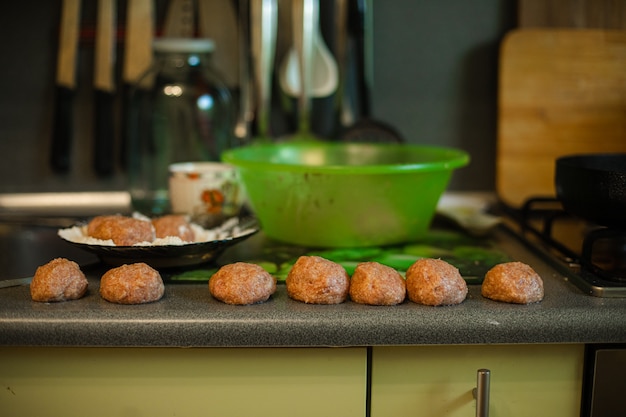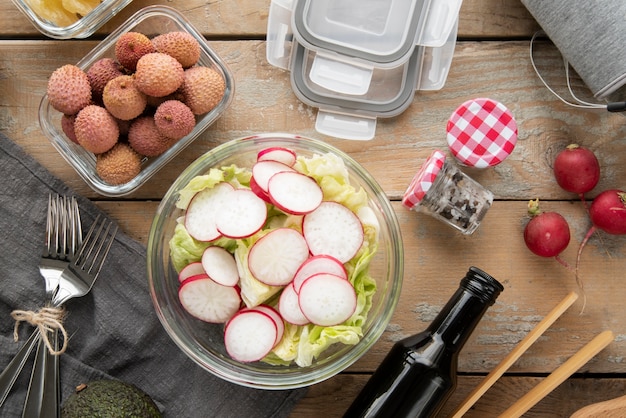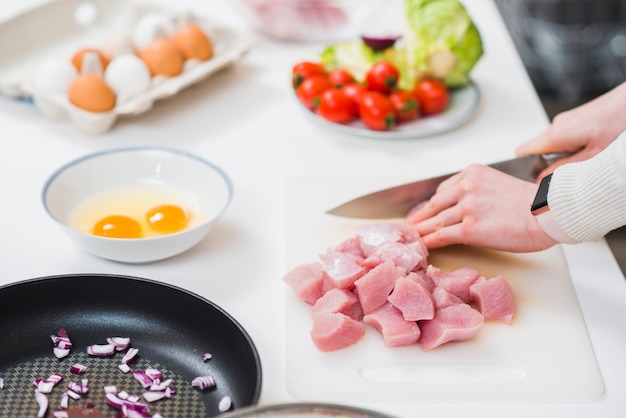Ah, meatballs. Those little bundles of joy that can either be a culinary triumph or a soggy, flavourless disaster. I've been on both sides of that coin, let me tell you. I've had meatballs so good they made me want to cry tears of happiness (and maybe lick the plate clean), and I've had some so bad, I wanted to throw them out the window (and maybe cry tears of disappointment). But fear not, my fellow meatball enthusiasts, because I'm here to share my hard-earned wisdom and guide you to meatball perfection.
This isn't just a recipe, it's a journey. We're going to delve into the heart of the meatball, exploring the secrets to juicy, flavorful, and perfectly cooked masterpieces. So grab a fork, a glass of something nice (a good red wine works wonders), and let's get cooking!
(Part 1) Choosing the Right Meat: The Foundation of a Great Meatball

You know how they say you can't build a house without a good foundation? Well, it's the same with meatballs. You need the right meat, the cornerstone of your meatball masterpiece. This isn't about just grabbing the first pack of ground beef you see; it's about choosing the right blend for the perfect flavour and texture.
The Meat Mix: A Symphony of Flavors
I've experimented with all sorts of meat combos over the years, and I've found that a good mix of ground beef, pork, and veal creates the best flavour and texture. The beef provides a hearty base, the pork adds juiciness, and the veal contributes a delicate flavour.
The ratio? Well, that's up to you. I usually go for 70% beef, 20% pork, and 10% veal, but you can play around with the proportions based on your own preferences. A classic Italian mix often uses a 50/50 split of beef and pork, while a more delicate option might use a higher percentage of veal.
The key is to get a blend that’s not too lean (or your meatballs will be dry and tough) and not too fatty (or they’ll be greasy and unappealing). You want a balance that creates a meatball that’s both flavourful and tender.
The Quality Matters: A Fresh Start
Now, don't get tempted by the cheapest meat you can find. Trust me, it's not worth the risk. You want meat that's fresh, well-marbled, and smells good. Look for a label that says "fresh" or "never frozen" for the best results.
If you can find a butcher who knows their stuff, all the better. They can help you choose the right blend and even grind it for you, giving you a head start on your meatball journey.
(Part 2) The Art of the Mix: Beyond the Meat

Okay, so you've got your meat sorted. Now, it's time to add some magic. This is where the real fun begins. It's about finding the perfect combination of ingredients to create those mouthwatering meatballs that leave everyone wanting more.
The Bread Crumbs: The Glue That Binds
You can't have a meatball without breadcrumbs, my friend. They act as the glue that holds everything together, adding structure and texture to your meatballs. But there are choices to be made.
Freshly Grated Breadcrumbs: These are my go-to. They soak up the moisture and add a lovely subtle flavor. To make your own, simply slice a few slices of crustless bread, remove the crust, and pulse them in a food processor until they resemble fine crumbs.
Dried Breadcrumbs: These are also good, but they can sometimes make the meatballs a bit dry. You might want to add a little extra liquid to counteract this.
panko breadcrumbs: These are a bit coarser and give the meatballs a nice crispy crust. They do tend to soak up more liquid, so be mindful.
Experiment and see what you prefer. I usually use a mixture of freshly grated and dried breadcrumbs to get the best of both worlds.
The Flavor Boosters: Herbs, Spices, and More!
This is where your creativity comes in! Meatballs are a blank canvas for flavor, and the possibilities are endless. Some of my favorite flavor-boosting additions include:
Fresh herbs: A handful of chopped parsley, oregano, basil, or thyme will add a burst of fresh flavor. Don't be afraid to get creative here. A pinch of rosemary, sage, or even a hint of cilantro can add a unique twist.
Garlic and onion: These are essential for creating a rich and aromatic base. You can use fresh or even a little garlic powder and onion powder in a pinch.
Eggs: These act as a binder and also add a bit of richness.
Milk: A splash of milk adds moisture and helps to make the meatballs extra tender.
Parmesan cheese: A generous sprinkle of grated Parmesan adds a salty, umami flavor. You can also use other cheeses like Pecorino Romano or even a blend of cheeses to create a more complex flavor profile.
Don't be afraid to experiment! Try different combinations, play with spices, and create your own unique signature meatball mix.
(Part 3) Mastering the Meatball Form: The Shape of Things to Come

Now, let's talk about the art of shaping. Your meatballs need to be perfectly formed, not only for aesthetic reasons but also because the shape affects how they cook.
The Importance of Uniformity: Even Cooking for Everyone
You want all your meatballs to be roughly the same size. This ensures they cook evenly and are ready to eat at the same time. Now, I know what you're thinking: "Who has time for perfect little spheres?" I'm with you. But trust me, the effort is worth it.
The Tools of the Trade: Making It Easy
You can use your hands to shape the meatballs, but if you want them to be extra round and smooth, a small ice cream scoop is a real lifesaver. It's quick, efficient, and guarantees perfectly sized meatballs every time.
The Role of the Pan: Space to Breathe
The pan you choose also plays a role. You want a pan that's large enough to hold all your meatballs without crowding them. This allows them to cook evenly and prevents them from steaming rather than browning. For a standard batch of meatballs, a 12-inch cast iron skillet or a large dutch oven works well.
(Part 4) The Art of the Brown: Getting that Beautiful Crust
You know that irresistible golden-brown crust that forms on a perfectly cooked meatball? That's not just about aesthetics; it's about flavor. That crispy crust is packed with flavor, and it's essential for a truly delicious meatball.
The Perfect Heat: The Goldilocks Zone
You need medium-high heat for the best results. If the heat is too low, the meatballs will steam rather than brown. If it's too high, the outside will burn before the inside is cooked through. Finding that sweet spot is key.
The Oil of Choice: Adding Flavor and Texture
Don't skimp on the oil. You need enough to create a nice, even coating on the meatballs. I prefer olive oil for its flavor, but you can use whatever you like. Other options include vegetable oil, canola oil, or even a little butter for a richer flavor.
The Browning Technique: A Simple Yet Crucial Step
Gently place the meatballs in the hot oil, making sure they aren't crowded in the pan. Brown them on all sides, about 3-4 minutes per side. This creates that beautiful crust and seals in all the delicious juices.
(Part 5) Beyond the Pan: Cooking Methods
Now, you've got those beautiful browned meatballs. Time to finish cooking them to perfection! You've got a few options here, each with its own unique flavor and texture.
The Classic oven method: Reliable and Easy
This is my go-to. After browning the meatballs, I transfer them to a baking sheet lined with parchment paper. Bake them in a preheated oven at 350°F (175°C) for about 20-25 minutes, or until cooked through.
The Sauce-Simmer Approach: Flavor Infusion
If you're making a sauce to go with your meatballs, you can simmer them in the sauce after browning. This gives the meatballs extra flavor and ensures they stay moist and tender. Just be careful not to overcrowd the pan, and make sure the sauce is bubbling gently.
The slow cooker Delight: Hands-Off Cooking
For those who love convenience, the slow cooker is a great option. Brown the meatballs first, then add them to your favorite slow cooker sauce. Cook on low for 4-6 hours, or until tender and cooked through. This method results in meatballs that are incredibly tender and fall-apart-soft.
(Part 6) The Tell-Tale Signs: Knowing When They're Done
You don't want to overcook those meatballs. Overcooked meatballs are dry, tough, and frankly, not very appealing. But you also don't want to undercook them. undercooked meatballs can be a bit risky.
The internal temperature Test: Scientific Accuracy
The most accurate way to tell if your meatballs are cooked through is to use a meat thermometer. Insert it into the center of a meatball, and make sure the internal temperature reaches 160°F (71°C).
The Visual Clues: A Quick Check
If you don't have a thermometer, you can look for some visual clues. The meatballs should be firm to the touch and no longer pink in the center. They should also be cooked through and no longer oozing raw meat juices.
(Part 7) The Art of the Sauce: The Perfect Complement
Okay, let's talk sauce. Meatballs are simply begging for a delicious sauce, whether it's a rich tomato sauce, a creamy alfredo sauce, or a tangy marinara sauce.
The Sauce Choices: A Flavorful Spectrum
Tomato-based sauces: These are classic, and there's a reason they're so popular. They're flavorful, rich, and pair perfectly with the meaty goodness of meatballs. You can find endless variations on this classic, from simple marinara to more complex sauces with herbs, spices, and even a touch of cream.
Creamy sauces: If you're feeling fancy, try a creamy sauce like Alfredo or a white wine sauce. These add a luxurious touch to your meatballs.
Marinara Sauce: This is a tangy and flavorful choice, perfect for those who want a bit of a kick.
Spicy Sauces: If you like your food with a bit of heat, try a spicy sauce like arrabbiata or a chili sauce.
The Sauce Technique: Bringing Out the Best
The key to a good sauce is to cook it slowly and allow the flavors to meld. Start with a base of onions, garlic, and your favorite herbs. Then add your chosen sauce ingredients and simmer until the flavors have deepened and the sauce has thickened.
The Meatball-Sauce Pairing: Harmony in Flavors
Remember, the sauce is a complement to the meatballs. You want a sauce that enhances the flavour of the meatballs, not overpowers it. Choose a sauce that complements the flavours of your meatball mix. For example, if your meatballs have a strong Italian flavour, a tomato-based sauce or marinara would be a good choice. If your meatballs are more neutral, you could try a creamy sauce or a white wine sauce.
(Part 8) The Meatball Experience: Serving and Enjoying
Your meatballs are cooked to perfection, the sauce is bubbling away, and it's time to enjoy the fruits of your labor. Let's talk about serving and savoring those delicious little bundles.
The Serving Style: A Versatile Dish
Meatballs can be served in a variety of ways. You can spoon them over pasta, rice, or polenta. They also make a great appetizer served with toothpicks or a dipping sauce. Get creative and find a serving style that suits your taste.
The Sides and Garnishes: Adding Balance and Beauty
Don't forget the sides! A simple green salad or a side of roasted vegetables can balance out the richness of the meatballs. You can also garnish your meatballs with fresh herbs, a sprinkle of Parmesan cheese, or a drizzle of balsamic glaze. Get fancy!
The Meatball Feast: A Moment to Savor
Now, it's time to sit back, relax, and enjoy the fruits of your labor. Take a moment to appreciate the aroma, the texture, and the explosion of flavor. And don't forget to share them with friends and family!
FAQs
You've got questions. I've got answers. Let's clear up some common meatball mysteries.
1. Can I Freeze Meatballs?
Absolutely! frozen meatballs are a lifesaver for busy nights. Just make sure you freeze them in a single layer on a baking sheet to prevent them from sticking together. Once they're frozen, you can transfer them to a freezer-safe bag. To reheat, just thaw them in the refrigerator overnight and then cook them according to your chosen method.
2. What Can I Do with Leftover Meatballs?
Leftover meatballs are a blessing in disguise. They're delicious reheated for lunch or dinner. You can also add them to salads, soups, or even use them as a filling for sandwiches. Get creative!
3. Should I Add Water or Milk to My Meatball Mix?
It depends on your chosen breadcrumbs. Fresh breadcrumbs tend to absorb a lot of liquid, so you might need to add a little water or milk to your mix. If you're using dried breadcrumbs, you can usually skip adding any additional liquid.
4. How Do I Prevent Meatballs from Falling Apart?
Make sure you don't overwork the meat mixture. Just mix it until it's combined. Also, use a good quality breadcrumbs and don't be afraid to add a bit of milk or egg to your mix.
5. Can I Use Ground Turkey or Chicken Instead of Beef?
You certainly can! Ground turkey and chicken can be a healthier alternative to beef. Just make sure you add a little extra fat, like olive oil or bacon, to keep the meatballs moist.
6. How Can I Make My Meatballs More Flavorful?
Add some spice: A pinch of red pepper flakes, cayenne pepper, or even a touch of smoked paprika can add a layer of complexity to your meatballs.
Embrace the aromatics: Incorporate some chopped herbs like parsley, oregano, thyme, or basil into your meatball mix for a fresh, herbaceous flavor.
Experiment with different cheeses: Beyond Parmesan, you can use other cheeses like ricotta, mozzarella, or even a blend of cheeses for a richer, more nuanced flavor.
Use a flavorful binder: Instead of traditional bread crumbs, try using crushed crackers, panko, or even finely chopped toasted bread for a unique twist.
7. What are some good accompaniments for meatballs?
Meatballs pair beautifully with a variety of sides. Here are a few ideas:
Pasta: A classic and comforting combination, especially with a rich tomato sauce.
Rice: A simple yet satisfying side that absorbs the flavors of the sauce.
Polenta: Creamy polenta provides a luxurious contrast to the meaty meatballs.
Roasted Vegetables: Add a burst of color and fresh flavors with roasted vegetables like broccoli, asparagus, or bell peppers.
Salads: A fresh and light counterpoint to the richness of the meatballs, especially a simple green salad with a light vinaigrette.
So, there you have it. My ultimate guide to perfectly cooked meatballs. Remember, it's all about experimenting, finding what you love, and having fun in the kitchen. Now, go out there and create some meatball magic!
Everyone is watching

Corn on the Cob: The Ultimate Guide to Perfectly Cooked Ears
Healthy MealsAh, corn on the cob. Just the name evokes images of sunny days, barbecues, and that sweet, juicy flavour that ...

Perfect Pork Roast Oven Cooking Time: A Guide to Delicious Results
Healthy MealsThere's something truly satisfying about a perfectly roasted pork. The aroma alone is enough to make your mout...

Scallops: The Ultimate Guide to Perfect Cooking
Healthy MealsAh, scallops. Those delicate, sweet, and utterly delicious morsels of the sea. They hold a special place in my...

Ham Cooking Time: How Long to Bake, Smoke, or Boil a Delicious Ham
Healthy MealsAh, ham. It's a classic, isn't it? A real crowd-pleaser, especially around holidays. And when done right, it'...

Spaghetti Squash: The Ultimate Guide to Cooking and Serving
Healthy MealsRemember that time you saw spaghetti squash at the supermarket, looking all bumpy and strange, and thought, "W...
